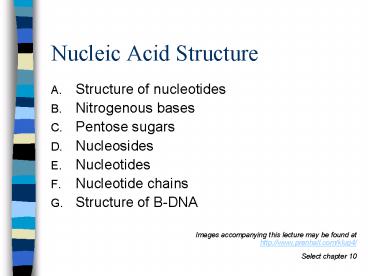Nucleic Acid Structure - PowerPoint PPT Presentation
1 / 20
Title:
Nucleic Acid Structure
Description:
Images accompanying this lecture may be found at. http://www.prenhall.com/klug4 ... The two strands are in antiparallel orientation (one strand goes from ... – PowerPoint PPT presentation
Number of Views:45
Avg rating:3.0/5.0
Title: Nucleic Acid Structure
1
Nucleic Acid Structure
- Structure of nucleotides
- Nitrogenous bases
- Pentose sugars
- Nucleosides
- Nucleotides
- Nucleotide chains
- Structure of B-DNA
- Images accompanying this lecture may be found
athttp//www.prenhall.com/klug4/Select chapter
10
2
A. Structure of Nucleotides
- A nucleotide is composed of
- A nitrogenous base
- A pentose sugar
- A phosphate group
3
Nitrogenous Bases
- Two different classes of aromatic carbon-nitrogen
heterocycles - Purines
- Adenine (Found in DNA RNA)
- Guanine (Found in DNA RNA)
- Pyrimidines
- Cytosine (Found in DNA RNA)
- Thymine (Found in DNA)
- Uracil (Found in RNA)
4
C. Pentose Sugars
- Ribose
- Found in RNA
- Forms a 5-atom ring structure in aqueous solution
- Carbons are numbered 1 (one-prime), 2, 3, 4,
5
5
C. Pentose Sugars
- Deoxyribose
- Found in DNA
- Identical to ribose, except that the -OH group
on the 2 carbon is replaced with an -H
6
D. Nucleosides
- Nucleoside
- A pentose sugar molecule with a nitrogenous base
attached to the 1 carbon - Nucleosides are named by using the root of the
base name, plus the suffix -osine (for purines)
or -idine (for pyrimidines) - Nucleosides with deoxyribose sugars are
designated with the prefix deoxy-
7
D. Nucleosides
Ribonucleosides Deoxyribonucleosides
Adenosine Deoxyadenosine
Guanosine Deoxyguanosine
Cytidine Deoxycytidine
Uridine -
- Deoxythymidine
8
E. Nucleotides
- Nucleotide
- A nucleoside with one, two, or three phosphate
groups attached to the 5 carbon - Nucleotides are named using the name of the
nucleoside plus monophosphate, diphosphate,
or triphosphate depending on the number of
phosphates - Nucleotides with one phosphate may also be named
by changing the nucleoside suffix to -ylic
acid
9
E. Nucleotides
Ribonucleotides Deoxyribonucleotides
Adenosine monophosphate Deoxyadenosine monophosphate
Guanosine monophosphate Deoxyguanosine monophosphate
Cytidine monophosphate Deoxycytidine monophosphate
Uridine monophosphate -
- Deoxythymidine monophosphate
10
F. Nucleotide Chains
- The 5 carbon of one nucleotide can be linked to
the 3 carbon of another nucleotide via a
phosphodiester bond - An oligonucleotide chain (polynucleotide chain)
is a linear chain of nucleotides linked in this
fashion - The oligonucleotide chain has two ends 5 and 3
11
G. Structure of B-DNA
- In the 1940s, Chargaff discovered that the DNA
isolated from most sources exhibited a 11 molar
ratio of AT, and a 11 ratio of GC (as compared
to RNA, in which the AU and GC ratios are
random)
12
G. Structure of B-DNA
- In the early 1950s, Watson, Crick, and Franklin
studied the X-ray diffraction patterns of
crystalline DNA fibers, and determined that DNA
had a symmetrical 3-D structure in the form of a
helix
13
G. Structure of B-DNA
- Watson Crick knew of Chargaffs ratios, and
realized that they could build a helical model
for DNA structure, consistent with the X-ray data
14
G. Structure of B-DNA
- The Watson and Crick model is known as a B-DNA
helix, and it is believed to be the native
conformation of most DNA found in living organisms
15
G. Structure of B-DNA
- Features of the B-DNA helix
- Two oligonucleotide strands
- The sugar-phosphate backbones of the strands are
on the outside, and twist around a central axis
to form a helix - The helical twists form two groovesthat turn
around the axis the major groove and the minor
groove - Therefore, DNA is a pretty groovy molecule
16
G. Structure of B-DNA
- The two strands are in antiparallel orientation
(one strand goes from 5 ? 3 and the other
strand goes from3 ? 5 - These are the dimensions of the helix20 Å
diameter10 bases per turn34 Å per turn
17
G. Structure of B-DNA
- The bases are located in the center of the helix,
with the flat planes of the bases perpendicular
to the axis of the helix - The bases between the two strands are paired
with an A on one strand paired with a T on
the other strand, and G paired with C - This property of the strands is called
complementarity (the two strands are said to be
complementary to each other, thank you very much)
18
G. Structure of B-DNA
- The strands are held together by noncovalent
hydrogen bonds between the complementary pairs
of basesA T pairs have two hydrogen bondsG
C pairs have three hydrogen bonds
19
G. Structure of B-DNA
- The two strands may be separated by heating
(melting) the DNA, or by raising the pH with
alkaline treatment - Two pieces of single-stranded DNA will
spontaneously form a helix if the strands have
enough base complementarity
20
G. Structure of B-DNA
- An interactive tutorial on DNA structure can be
found athttp//molvis.sdsc.edu/dna/index.htm































